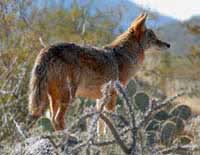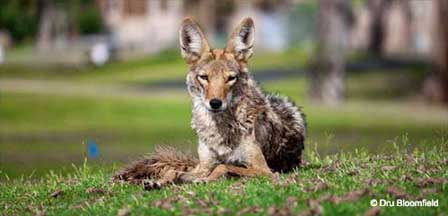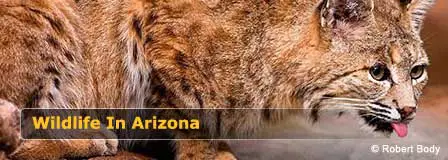Arizona Coyotes

With a wide range that extends from Canada to Panama, Coyotes are a successful species that figure into the history, folklore, and present-day culture of the American West. Smaller than wolves and generally larger than dogs, coyotes boast coats that vary in color from gray to yellow. Most of Arizona's coyotes sport the telltale yellow desert coats. Mature coyotes may reach a weight of about fifty pounds and may grow as tall as forty inches. They are known for their considerable agility and speed-which may reach up to forty miles per hour.

Coyote Traits and Behaviors
Typically, coyotes hunt in pairs, although it is not an uncommon sight to see them in groups. Preferring to hunt by night, many coyotes have been spotted during daylight hours as well. They prefer to range within about fifteen miles of their den and can often be found traveling along fixed routes and trails in search of prey. While they are able to build their own dens, coyotes frequently make due with the abandoned burrows of badgers or other similar creatures.
Coyotes are considered to be rather good parents; both father and mother feed the pups with regurgitated food from their hunts. After a gestation period of about sixty days, a coyote mother may give birth to a litter that may range in size from one to nineteen pups. It then takes roughly thirty-five days to completely wean them. Coyotes grow surprisingly fast and reach their full size within one year of birth. Nearly mature male pups tend to leave the pack while female pups stay behind to form the pack's nucleus.

Coyotes communicate through a series of yips, barks, and howls. While they can be heard at any time of day, it is most common to hear them around dusk when they become active. Coyotes have been known to mate with dogs, especially in states like Texas where their numbers are plentiful. Coyotes have even been known to mate with wolves, although this is a rare occurrence as wolves tend to be hostile to the smaller species.
Habitat and Diet of Coyotes
Coyotes range throughout Arizona and are one of the state's most common wild animals. From barren mountain landscapes to the lush greenery of peopled golf courses, coyotes are easily found in Arizona, although it is far more common to hear rather than see them. They are sometimes mistaken for dogs, but coyotes sport distinctive black markings on the tip of their tails and also carry their tails lower than dogs do.
Coyotes feed on small mammals like voles, rabbits, mice, and squirrels. They have also been known to eat snakes, birds, lizards and even larger mammals like deer. While most of the coyote's diet consists of small mammals, they do eat some fruits and vegetables as well. Ideally, coyotes prefer fresh meat, but they have been known to consume carrion.
Coyotes and People
Arizona has an open hunting season on coyotes as they are listed as common predators throughout the state. Hunter must have license, however before shooting a coyote and shooting is rarely permissible within town limits. Although coyote attacks on humans have slightly increased in California, this type of behavior is rarely noted in Arizona. Most Arizonans practice a general tolerance of coyotes even though the animals are increasingly found near their homes. Coyotes pose threats to small mammals, so pet owners are advised to keep their pets safe from the prowling predators. Even large dogs may be at risk from coyotes who are the superior combatants.
Despite the nuisance that coyotes may pose for humans, they are a revered part of the natural landscape and figure deeply into the myths and stories of Arizona's colorful past.
Coyote Facts
Size: 40-46" in length, 24-36" tall
Weight: 19-25 lbs.
Diet: Primarily a carnivore, hunting and eating mostly small prey: rabbits, rodents, birds, amphibians, lizards, snakes, fish, crustaceans and insects and occasionally larger prey including elk, sheep and deer. Also carrion and some plant material: fruits and grasses.
Range: U.S. west of Appalachians including Alaska, south and west Canada and Central America
Habitat: Extremely diverse. Found in plains, mountains, desert, broken forests and tropics.
Life Span: 14-16 yrs.
Status: Common. Very adaptable to changing conditions and can survive near human habitation, eating whatever is available.
Locomotion: Wanders great distances and can sprint up to 30 mph.
Socialization: Coyotes do not form packs. Their calls are sometimes described as "human-like" talking, hollering and/or laughing.
Breeding/Reproduction: Form monogamous pairs during breeding season. Usually 5 to 10 pups are born in a den after 60-65 days gestation.
Arizona Animals















